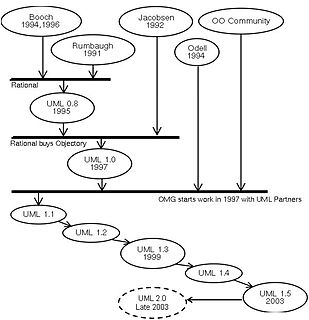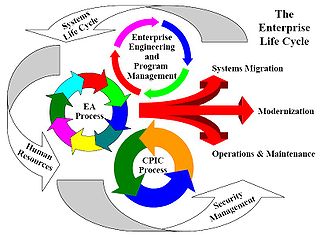ERP modeling, is the process of reverse engineering an Enterprise Resource Planning software package in order to align it to an organizational structure.
ERP modeling, is the process of reverse engineering an Enterprise Resource Planning software package in order to align it to an organizational structure.
Although ERP modeling could possibly be performed by several methodologies, this entry deals with ERP modeling using Object Process Methodology, or OPM.
OPM appears to be a usable methodology for modeling ERP systems, as the methodology focuses on optionality within objects and processes of an ERP system.
ERP modeling is done by analyzing the optionality within an ERP system to identify the different functions of the system that the end-using company needs, regarding its organizational structure. Reverse engineering both ERP system and organizational structure to the same level of granularity makes both layers compatible for aligning the package in the organization.
ERP breaks down traditional functional barriers by facilitating data sharing, information flows, and the introduction of common business practices among all organizational users.
A Global Business Process Model is created which represents the whole ERP software product. This model is layered in 3 deeper levels.
The meta model below depicts the optionality levels of ERP modeling.
The optionality leveling is used to reverse engineer the ERP system and the organizational structure to its full extent. Once properly mapped, both aspects are fully alignable or at least compatible to be matched.
The correct way to align both ERP and organizational models is as follows:
process occurrences. Because this level elaborates on object parameters, the optionality is very dynamic, meaning that options can easily be altered.
The meta model below depicts the optionality levels of ERP modeling.
The optionality leveling is used to reverse engineer the ERP system and the organizational structure to its full extent. Once properly mapped, both aspects are fully alignable or at least compatible to be matched.
The correct way to align both ERP and organizational models is as follows

In computing, a database is an organized collection of data stored and accessed electronically. Small databases can be stored on a file system, while large databases are hosted on computer clusters or cloud storage. The design of databases spans formal techniques and practical considerations including data modeling, efficient data representation and storage, query languages, security and privacy of sensitive data, and distributed computing issues including supporting concurrent access and fault tolerance.

Enterprise resource planning (ERP) is the integrated management of main business processes, often in real time and mediated by software and technology. ERP is usually referred to as a category of business management software—typically a suite of integrated applications—that an organization can use to collect, store, manage, and interpret data from many business activities. ERP Systems can be local based or Cloud-based. Cloud-based applications have grown in recent years due to information being readily available from any location with internet access.

An object-modeling language is a standardized set of symbols used to model a software system using an object-oriented framework. The symbols can be either informal or formal ranging from predefined graphical templates to formal object models defined by grammars and specifications.

The Unified Modeling Language (UML) is a general-purpose, developmental, modeling language in the field of software engineering that is intended to provide a standard way to visualize the design of a system.
Software development is the process of conceiving, specifying, designing, programming, documenting, testing, and bug fixing involved in creating and maintaining applications, frameworks, or other software components. Software development involves writing and maintaining the source code, but in a broader sense, it includes all processes from the conception of the desired software through to the final manifestation of the software, typically in a planned and structured process. Software development also includes research, new development, prototyping, modification, reuse, re-engineering, maintenance, or any other activities that result in software products.

In systems engineering, information systems and software engineering, the systems development life cycle (SDLC), also referred to as the application development life-cycle, is a process for planning, creating, testing, and deploying an information system. The systems development life cycle concept applies to a range of hardware and software configurations, as a system can be composed of hardware only, software only, or a combination of both. There are usually six stages in this cycle: requirement analysis, design, development and testing, implementation, documentation, and evaluation.

In industry, Product Lifecycle Management (PLM) is the process of managing the entire lifecycle of a product from its inception through the engineering, design and manufacture, as well as the service and disposal of manufactured products. PLM integrates people, data, processes and business systems and provides a product information backbone for companies and their extended enterprises.
Structured Systems Analysis and Design Method (SSADM), originally released as methodology, is a systems approach to the analysis and design of information systems. SSADM was produced for the Central Computer and Telecommunications Agency, a UK government office concerned with the use of technology in government, from 1980 onwards.

The Zachman Framework is an enterprise ontology and is a fundamental structure for enterprise architecture which provides a formal and structured way of viewing and defining an enterprise. The ontology is a two dimensional classification schema that reflects the intersection between two historical classifications. The first are primitive interrogatives: What, How, When, Who, Where, and Why. The second is derived from the philosophical concept of reification, the transformation of an abstract idea into an instantiation. The Zachman Framework reification transformations are: identification, definition, representation, specification, configuration and instantiation.
A product software implementation method is a systematically structured approach to effectively integrate a software based service or component into the workflow of an organizational structure or an individual end-user.

Object Process Methodology (OPM) is a conception modeling language and methodology for capturing knowledge and designing systems, specified as ISO/PAS 19450. Based on a minimal universal ontology of stateful objects and processes that transform them, OPM can be used to formally specify the function, structure, and behavior of artificial and natural systems in a large variety of domains.
Dynamic enterprise modeling (DEM) is an enterprise modeling approach developed by the Baan company, and used for the Baan enterprise resource planning system which aims "to align and implement it in the organizational architecture of the end-using company".
Feature-driven development (FDD) is an iterative and incremental software development process. It is a lightweight or Agile method for developing software. FDD blends a number of industry-recognized best practices into a cohesive whole. These practices are driven from a client-valued functionality (feature) perspective. Its main purpose is to deliver tangible, working software repeatedly in a timely manner in accordance with the Principles behind the Agile Manifesto.

Enterprise modelling is the abstract representation, description and definition of the structure, processes, information and resources of an identifiable business, government body, or other large organization.
Legacy modernization, also known as software modernization or platform modernization, refers to the conversion, rewriting or porting of a legacy system to modern computer programming languages, architectures, software libraries, protocols or hardware platforms. Legacy transformation aims to retain and extend the value of the legacy investment through migration to new platforms to benefit from the advantage of the new technologies.

Enterprise life cycle (ELC) in enterprise architecture is the dynamic, iterative process of changing the enterprise over time by incorporating new business processes, new technology, and new capabilities, as well as maintenance, disposition and disposal of existing elements of the enterprise.
A metaCASE tool is a type of application software that provides the possibility to create one or more modeling methods, languages or notations for use within the process of software development. Often the result is a modeling tool for that language. MetaCASE tools are thus a kind of language workbench, generally considered as being focused on graphical modeling languages.
Design & Engineering Methodology for Organizations (DEMO) is an enterprise modelling methodology for transaction modelling, and analysing and representing business processes. It is developed since the 1980s by Jan Dietz and others, and is inspired by the language/action perspective
In software engineering, a software development process is a process of dividing software development work into smaller, parallel, or sequential steps or sub-processes to improve design, product management. It is also known as a software development life cycle (SDLC). The methodology may include the pre-definition of specific deliverables and artifacts that are created and completed by a project team to develop or maintain an application.
Dov Dori is an Israeli-American computer scientist, and Professor of Information Systems Engineering at Technion – Israel Institute of Technology, known for the development of Object Process Methodology (OPM). The ideas underlying OPM were published for the first time in 1995.